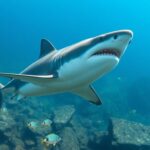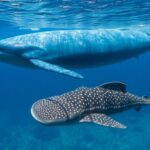Key Takeaways
- Shark Species in the Adriatic: The Adriatic Sea hosts several shark species, including the smooth hammerhead, blue shark, and sandbar shark, though they are not frequently seen by beachgoers.
- Habitat Diversity: Sharks in this region inhabit various environments such as coastal areas, continental shelves, and deeper waters, with their presence influencing local marine ecosystems.
- Rare Sightings and Safety: Shark sightings attract divers and tourists, but encounters with aggressive sharks are extremely rare, making the Adriatic Sea a safe environment for swimming and diving.
- Conservation Status: Many of the shark species found in the Adriatic are categorized as “Near Threatened” or “Vulnerable,” highlighting the importance of ongoing conservation efforts to protect these marine creatures.
- Human Interaction: Educational initiatives and monitoring programs are in place to promote safer interactions and enhance public awareness about the role of sharks in marine ecosystems.
- Encouragement for Exploration: Understanding the presence of sharks and their habitats can enrich your experience exploring the Adriatic Sea, encouraging both appreciation and conservation of its unique marine life.
When you think of the Adriatic Sea, images of stunning coastlines and vibrant marine life likely come to mind. But what about sharks? You might be surprised to learn that yes, there are sharks in the Adriatic Sea, though they’re not as common as you might think.
Overview of Sharks in the Adriatic Sea
The Adriatic Sea hosts several shark species, though the population density is lower compared to other global waters. Notable species include the smooth hammerhead, blue shark, and sandbar shark. While sharks in this region aren’t commonly sighted by beachgoers, they play a crucial role in maintaining marine ecosystems.
Species of Sharks Frequently Found
| Shark Species | Scientific Name | Typical Size (feet) | Conservation Status |
|---|---|---|---|
| Smooth Hammerhead | Sphyrna zygaena | 10-13 | Near Threatened |
| Blue Shark | Prionace glauca | 10-12 | Near Threatened |
| Sandbar Shark | Carcharhinus plumbeus | 6-10 | Near Threatened |
| Spiny Dogfish | Squalus acanthias | 2-4 | Least Concern |
Habitat and Behavior
You may encounter sharks in various habitats within the Adriatic Sea, such as coastal areas, continental shelves, and deeper waters. Sharks exhibit migratory behavior, often moving between regions depending on water temperatures and prey availability.
Shark Sightings and Tourism
Occasional shark sightings attract divers and researchers, contributing to marine tourism in the region. Activities like scuba diving expeditions provide opportunities to observe these animals in their natural habitats. Locations like the Tuscan Archipelago and the Brijuni Islands are prime areas for diving due to their rich biodiversity.
Risk to Humans
Shark attacks in the Adriatic Sea are rare. According to data from the International Shark Attack File, the likelihood of encountering aggressive sharks is minimal, making the region safe for swimmers and divers. Understanding local shark behavior can enhance your appreciation of these creatures while engaging in coastal activities.
While sharks inhabit the Adriatic Sea, their presence tends to be understated. Knowledge of species, habitats, and safety measures enriches your experience when exploring this unique marine environment.
Common Shark Species Found
Several shark species inhabit the Adriatic Sea, each playing a crucial role in the marine ecosystem. Below are the main species you might encounter.
Blue Sharks
Blue sharks (Prionace glauca) are one of the most common species in the Adriatic. Recognizable for their long, slender bodies and vibrant blue coloration, these sharks can reach lengths of up to 12.1 feet (3.7 meters). They prefer deeper waters but can occasionally be seen near the surface during hunting.
| Characteristic | Detail |
|---|---|
| Maximum Length | 12.1 feet (3.7 meters) |
| Common Habitat | Deep waters |
| Diet | Fish, cephalopods |
| Conservation Status | Near Threatened |
Hammerhead Sharks
Smooth hammerhead sharks (Sphyrna zygaena) inhabit the Adriatic, known for their distinctive hammer-shaped heads. These sharks can grow around 10.5 feet (3.2 meters) in length. They often reside in coastal areas and shallow waters, where they primarily feed on schools of fish and squid.
| Characteristic | Detail |
|---|---|
| Maximum Length | 10.5 feet (3.2 meters) |
| Common Habitat | Coastal, shallow waters |
| Diet | Fish, squid |
| Conservation Status | Vulnerable |
Other Notable Species
Other notable shark species found in the Adriatic include the sandbar shark (Carcharhinus plumbeus) and the shortfin mako (Isurus oxyrinchus). Sandbar sharks can reach lengths of 8.5 feet (2.6 meters) and prefer shallow, warm waters. The shortfin mako, recognized for its speed, can grow up to 13 feet (4 meters) and is typically found in deeper offshore waters.
| Species | Maximum Length | Common Habitat | Conservation Status |
|---|---|---|---|
| Sandbar Shark | 8.5 feet (2.6 meters) | Shallow, warm waters | Near Threatened |
| Shortfin Mako | 13 feet (4 meters) | Deep offshore waters | Vulnerable |
Shark Habitat and Behavior
Sharks in the Adriatic Sea occupy specific environments that support their survival and feeding. Understanding these aspects provides insight into their role in marine ecosystems.
Preferred Environments
Sharks prefer diverse habitats within the Adriatic Sea. Key environments include:
| Environment | Description | Notable Species |
|---|---|---|
| Coastal Areas | Shallow waters near beaches | Smooth hammerhead, sandbar |
| Open Waters | Deeper areas away from the shore | Blue shark, shortfin mako |
| Estuaries | Brackish waters where rivers meet | Various juvenile species |
These habitats offer essential resources, such as prey and shelter. Coastal sharks often seek warmer waters, while deeper-sea species migrate based on temperature and food sources.
Feeding Habits
Sharks in the Adriatic exhibit diverse feeding behaviors. Common feeding strategies include:
| Species | Diet | Method of Feeding |
|---|---|---|
| Blue Shark | Fish, squid | Fast swimming, open-water hunting |
| Smooth Hammerhead | Bottom-dwelling fish, rays | Foraging and ambushing |
| Sandbar Shark | Bony fish, crustaceans | Benthic feeding techniques |
Sharks typically locate prey using keen senses, including smell and lateral line systems. These feeding habits contribute to maintaining balance in the ecosystem by controlling fish populations.
Human Interaction with Sharks
Human interaction with sharks in the Adriatic Sea focuses on understanding their ecology and minimizing risks associated with encounters. Awareness and education about sharks support safer interactions and conservation efforts.
Shark Attacks
Shark attacks in the Adriatic Sea are exceedingly rare. Data indicates only a handful of incidents recorded over recent decades. Factors for this low occurrence include the limited shark population and the species present, generally posing minimal threat to humans. The table below summarizes shark attack statistics in the Adriatic:
| Year | Number of Attacks | Fatalities | Notable Incidents |
|---|---|---|---|
| 2000 | 1 | 0 | Minor injury |
| 2010 | 0 | 0 | None |
| 2020 | 1 | 0 | Minor injury |
| 2023 | 0 | 0 | None |
Understanding these statistics emphasizes the safety of engaging in water activities in the region, allowing for a more enjoyable seaside experience.
Conservation Efforts
Conservation efforts for sharks in the Adriatic Sea emphasize the importance of maintaining healthy marine ecosystems. Organizations and researchers collaborate to monitor shark populations and protect their habitats. Notable initiatives include:
- Protected Areas: Designation of marine protected areas to preserve biodiversity.
- Research Programs: Studies tracking migration patterns and population health.
- Public Education: Programs aimed at raising awareness about shark conservation.
These efforts aim to balance human activity with marine conservation, ensuring that shark populations continue thriving. In this way, your understanding and support can contribute to the preservation of these vital marine species.
Conclusion
Exploring the Adriatic Sea reveals a fascinating yet understated world of sharks. While you may not encounter them often, their presence is vital for maintaining the health of marine ecosystems. Understanding the various species and their habitats enhances your appreciation for this unique environment.
With minimal risk to swimmers and divers, you can enjoy the beauty of the Adriatic while knowing that these creatures play an essential role in the ocean’s balance. As awareness grows about shark conservation, your engagement in responsible marine activities can contribute to the protection of these incredible animals. Embrace the wonders of the Adriatic Sea and the hidden treasures it holds beneath the waves.
Frequently Asked Questions
Are there sharks in the Adriatic Sea?
Yes, there are sharks in the Adriatic Sea, although they are not as common as in other waters. Species like the smooth hammerhead, blue shark, and sandbar shark inhabit the region, playing a vital role in the marine ecosystem.
What species of sharks are found in the Adriatic Sea?
The Adriatic Sea is home to several shark species, including the blue shark, smooth hammerhead, sandbar shark, and shortfin mako. These sharks vary in size and habitat preferences.
How dangerous are sharks to swimmers in the Adriatic?
Shark attacks in the Adriatic Sea are extremely rare, with only a few incidents recorded in recent decades. Swimmers and divers can generally enjoy these waters with minimal risk.
Where can you find sharks in the Adriatic Sea?
Sharks in the Adriatic can be found in various habitats, including coastal areas, open waters, and estuaries. Each environment supports different species and feeding behaviors.
What is the average size of sharks in the Adriatic Sea?
Shark sizes vary by species: blue sharks can grow up to 12.1 feet, smooth hammerheads reach about 10.5 feet, and sandbar sharks can be up to 8.5 feet long, while shortfin makos can reach 13 feet.
How do sharks maintain the ecosystem in the Adriatic Sea?
Sharks play a crucial role in maintaining ecological balance by controlling fish populations. Their feeding behaviors help regulate the marine life that supports a healthy ecosystem.
What conservation efforts are in place for sharks in the Adriatic?
Conservation initiatives include the establishment of marine protected areas, research on migration patterns, and public education to raise awareness about shark conservation and the importance of healthy marine ecosystems.

I am a passionate explorer of the deep sea, endlessly fascinated by the mysteries that lie beneath the ocean’s surface. From the graceful glide of a manta ray to the powerful presence of a great white shark, I find inspiration in every creature that calls the sea its home. My love for marine life began at an early age and has grown into a lifelong mission to study, understand, and share the wonders of our blue planet. Through Planet Shark Divers, I combine my enthusiasm for sharks and other sea animals with a dedication to education and conservation. Each article is crafted to unravel myths, reveal fascinating facts, and inspire respect for the extraordinary life forms that thrive in the depths. Whether it’s the biology of a hammerhead or the mystery of the deep abyss, my goal is to bring the ocean closer to everyone’s heart and mind.


